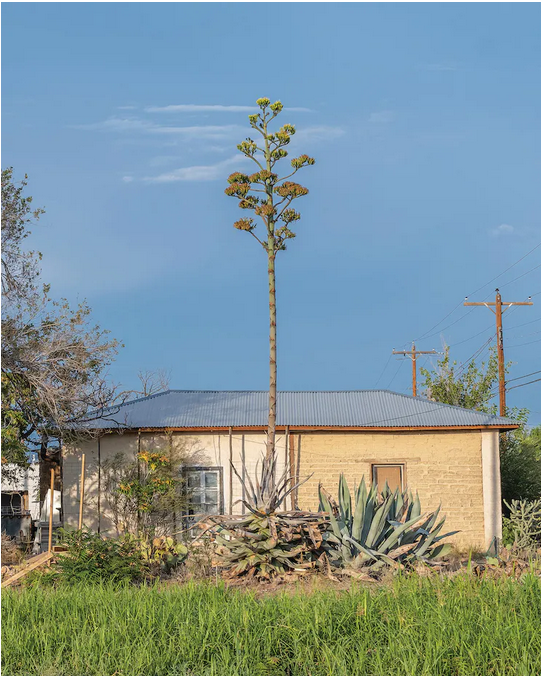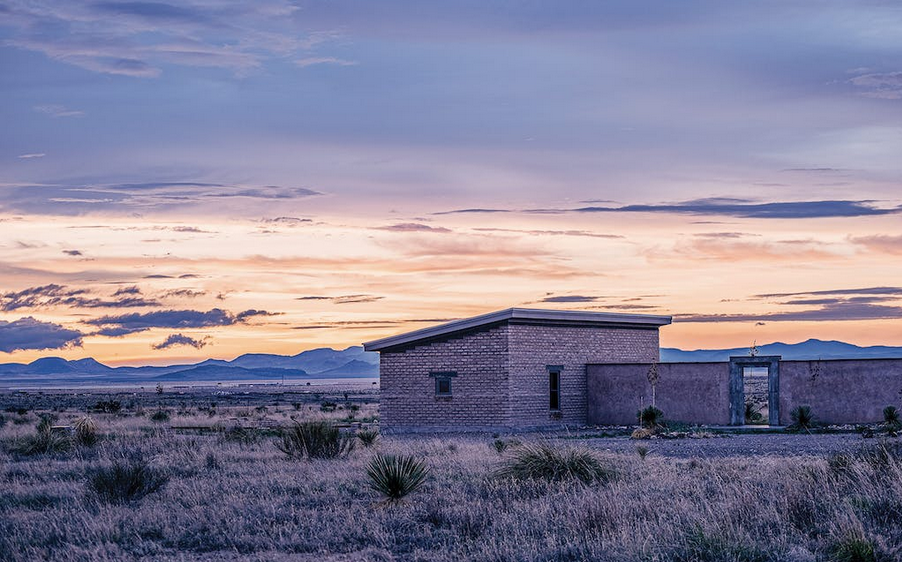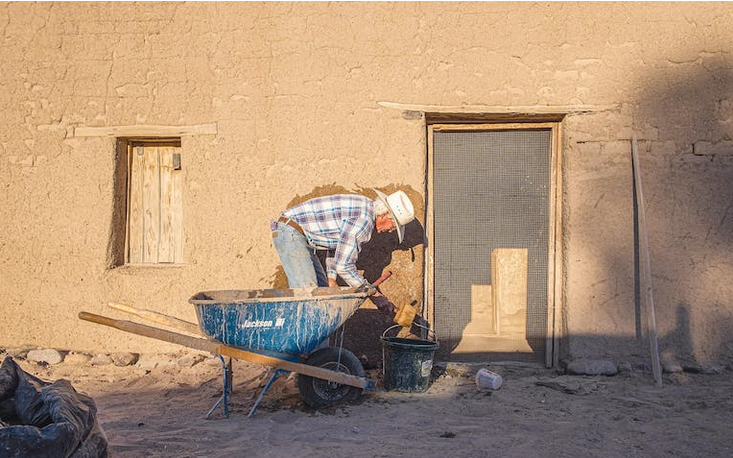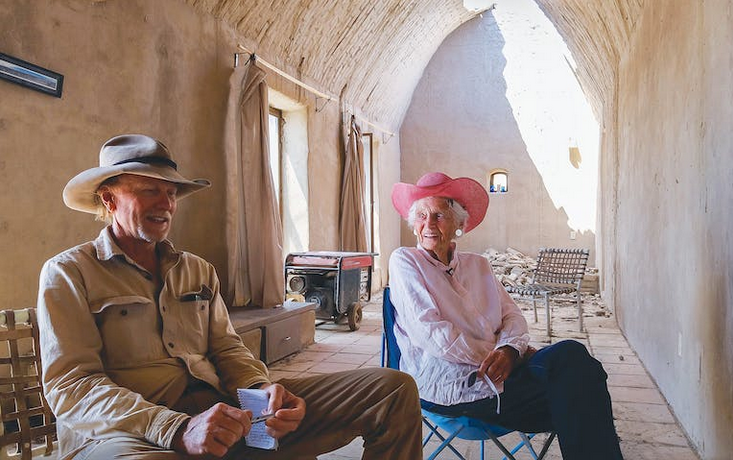Adobe is the humblest of building materials, for which earth, straw, and water are formed into bricks and then dried in the sun. It appears in arid places where dirt is the cheapest and most abundant natural resource. Adobe buildings have thick walls for structural integrity, and the earthen bricks can keep the interior cool. Some of the world’s oldest cities, going back to 9500 BC, were made of mud bricks. But as ancient as it is, adobe remains contemporary. Perhaps half the planet’s population lives in earthen houses.
 Adobe buildings are common throughout West Texas, especially in the Big Bend area. Half of Marfa’s houses are adobe with examples both grand and rustic. Unlike the iconic, softly rounded edges of New Mexico adobe houses, Marfa’s are typically quite stark or retain elements of whatever style was popular at the time of construction.
Adobe buildings are common throughout West Texas, especially in the Big Bend area. Half of Marfa’s houses are adobe with examples both grand and rustic. Unlike the iconic, softly rounded edges of New Mexico adobe houses, Marfa’s are typically quite stark or retain elements of whatever style was popular at the time of construction.
Marfa was that place where a lot of people who were cash-strapped built lives while building their houses. These days, those opportunities seem harder to find, since even the cheapest adobe homes are desirable and valuable. Yet despite those obstacles, some folks who really want to live there have turned to adobe’s old tradition and the earth beneath their feet to do something not so simple at all: commit to a place, make a life, create a home.
 On the front of a house owned by Michael Camacho and Mallory Jones hangs a single strand of Christmas lights and blue-and-white posters emblazoned with the image of a cowboy-hatted man holding a large brick. “Defend the Adobes,” says one. “Adobe Is Political,” reads another. Bought from the city in a delinquent tax auction in 2017, the place has two small original rooms nearly at street level, a classic 1920s adobe. More than a hundred homemade adobe bricks lie drying in the yard; hundreds more finished bricks are stacked nearby. No one lives here yet, but if all goes according to plan the couple and their sons will move in within the next year. “The goal is to prove that building with adobe is cost-effective,” says Camacho. “And to empower people that they can build it themselves,” Jones says.
On the front of a house owned by Michael Camacho and Mallory Jones hangs a single strand of Christmas lights and blue-and-white posters emblazoned with the image of a cowboy-hatted man holding a large brick. “Defend the Adobes,” says one. “Adobe Is Political,” reads another. Bought from the city in a delinquent tax auction in 2017, the place has two small original rooms nearly at street level, a classic 1920s adobe. More than a hundred homemade adobe bricks lie drying in the yard; hundreds more finished bricks are stacked nearby. No one lives here yet, but if all goes according to plan the couple and their sons will move in within the next year. “The goal is to prove that building with adobe is cost-effective,” says Camacho. “And to empower people that they can build it themselves,” Jones says.
The couple bid $38,000 for the six-hundred-square-foot house at a local tax auction. It had sustained a fire sometime in the past. It no longer had workable plumbing or an electrical system—it was just a shell. “There’s no way we could afford any other house in Marfa,” says Camacho.
Nearly all of Marfa’s public school students are deemed economically disadvantaged. But houses, even very modest ones, aren’t generally available for less than $250,000. Folks who’ve been here for generations typically own their homes outright, so when they sell in this hot market, the deal delivers a great profit. For those who arrived in more recent years, however, home ownership can be a distant aspiration. Wealthy second-home buyers have the means and the desire to move shockingly fast on available listings, and adobe is usually preferred.
This atmosphere has made even renting a challenge. In a market where vacation rentals soak up the housing stock, there are few available long-term rentals, and the rent can be quite dear.
 In Marfa over the past couple of decades the prices that buyers were paying outpaced the tax valuations set by the appraisal district. When the state comptroller’s office leaned on the appraisal district eight years ago to close the gap between market values and appraised values, the district complied, and appraised values have subsequently risen 361 percent. That year, 85 percent of adobe-home owners protested their valuations. In essence, in Marfa, if you own a house made of adobe, the humblest of building materials, you’re going to owe more taxes.
In Marfa over the past couple of decades the prices that buyers were paying outpaced the tax valuations set by the appraisal district. When the state comptroller’s office leaned on the appraisal district eight years ago to close the gap between market values and appraised values, the district complied, and appraised values have subsequently risen 361 percent. That year, 85 percent of adobe-home owners protested their valuations. In essence, in Marfa, if you own a house made of adobe, the humblest of building materials, you’re going to owe more taxes.
 The district’s decision to assign a higher value to adobe homes incensed Sandro Canovas, a Mexico-born adobero and activist who now lives in Marfa. All over town he slapped up the posters that read “Adobe Is Political” and “Defend the Adobes.” “I come from a family of brickmakers,” he says. “I have it in my blood.” He maintains that the appraisal hike is innately unfair, since those who have traditionally built and lived in these homes are hit hardest. “It’s outrageous what the appraisal district has done,” he says. “They took something that was available to everybody and gave it to the very wealthy. People with no historic or cultural connection to adobe or people who would never mingle culturally now possess this architecture—because it’s cool to have an adobe home.”
The district’s decision to assign a higher value to adobe homes incensed Sandro Canovas, a Mexico-born adobero and activist who now lives in Marfa. All over town he slapped up the posters that read “Adobe Is Political” and “Defend the Adobes.” “I come from a family of brickmakers,” he says. “I have it in my blood.” He maintains that the appraisal hike is innately unfair, since those who have traditionally built and lived in these homes are hit hardest. “It’s outrageous what the appraisal district has done,” he says. “They took something that was available to everybody and gave it to the very wealthy. People with no historic or cultural connection to adobe or people who would never mingle culturally now possess this architecture—because it’s cool to have an adobe home.”
 Once people do renovate or build, a sticky problem arises. “The ‘adobe tax’ has been so detrimental to earthen and vernacular architecture because it doesn’t allow anyone who already owns an adobe to work on it,” says Canovas. “The moment you try to do something with adobe in this County, it’s immediately going to be taxed higher.” More and more houses stand empty except when tourists are renting them. The town’s population has declined nearly a quarter since the 2000 census.
Once people do renovate or build, a sticky problem arises. “The ‘adobe tax’ has been so detrimental to earthen and vernacular architecture because it doesn’t allow anyone who already owns an adobe to work on it,” says Canovas. “The moment you try to do something with adobe in this County, it’s immediately going to be taxed higher.” More and more houses stand empty except when tourists are renting them. The town’s population has declined nearly a quarter since the 2000 census.
Now 93, Simone Swan is petite, and her eyes are bright as dimes. A crowd has gathered in her honor in the home she named Swan House. As an art world sophisticate in the seventies and eighties, Swan was a friend and protégé of the Egyptian architect Hassan Fathy, whose life’s work and book Architecture for the Poor advocated building all-earthen construction to house people with few financial resources.
Fathy’s approach to building required no wood, no concrete—just bricks made on-site from earth. Swan was convinced that Fathy’s adobe vaults and domes would be a superior, cheaper way to build low-income housing. In 1995, determined to prove adobe’s cost-effectiveness and potential, Swan and Jesusita Jimenez built a $5,000 prototype home. Workers dug the dirt for bricks and plaster on-site, and adobe furniture was integrated into the form of the house itself. Swan’s ambition, she says, was “to have an alternate architecture in the West that is healthy, comfortable, and structurally sound,” and she pitched the idea of affordable adobe construction to various political and municipal figures in Texas and Mexico. The idea, however, never caught on; government wonks didn’t follow up, banks at the time weren’t keen on new-build construction loans for adobe homes, she says.
Undaunted, Swan pursued a more personal project. On a high plain overlooking the unfolding canyons below, she built Swan House, a serene, almost churchlike H-shaped structure with Fathy’s soaring Nubian vaults and domes. Concurrent with its construction, she created a nonprofit, Adobe Alliance, and for years she, Jimenez, and a string of interns and volunteers held hands-on adobe workshops using the house as their test site. Their rallying cry: adobe is political.
“Adobe will be increasingly more of a political issue,” Swan prognosticated in an essay from the early aughts. “As building materials rise even higher in cost than in this first decade of the twenty-first century; as industrial materials’ toxicity is perceived, as their cost of transportation increases with the price of fuels; as the climatic comfort of adobe walls are discovered, more budget-conscious dwellers will be drawn to the material.”
Swan House has stood empty for a long while, after health issues required Swan to move to Tucson. In her absence, some of the vaults failed and fell. Her return to the house in April, however, came with great optimism.
 At the gathering in her honor, David Keller steps forward, dressed in a desert-tan, all-denim ensemble. Keller is a Big Bend archaeologist whose avid dedication to natural building techniques includes participating in Swan House workshops back in the day. He and five other adobe-minded folks pooled resources to buy Swan House. They’ve pledged to restart the workshops, teaching adobe skills to all-new participants, using the house as a lab to return it to its former glory.
At the gathering in her honor, David Keller steps forward, dressed in a desert-tan, all-denim ensemble. Keller is a Big Bend archaeologist whose avid dedication to natural building techniques includes participating in Swan House workshops back in the day. He and five other adobe-minded folks pooled resources to buy Swan House. They’ve pledged to restart the workshops, teaching adobe skills to all-new participants, using the house as a lab to return it to its former glory.
“Swan House was a big deal in the adobe world and architectural circles and to people of the region,” Keller says to the twenty or so people who have assembled. “It’s a cultural asset.” He aims to create the ideal recipe to remake and replaster the house’s vaults and domes. No one is certain how to solve all of Swan House’s issues—the fallen vaults, for instance. That’s okay. “If you take this property, you take its problems and you take its challenges, dealing with domes and vaults that are exposed adobe in the desert,” Keller says. “Can it be done? That’s the challenge. Are we up to it? I’m willing to try.”
For generations, adobe houses were made of mud bricks with mud mortar, covered by mud plaster, lime plaster, or whitewash. A house built in such a way, where the bricks, mortar, and plaster are a single breathing unit, requires maintenance every couple of years—a weekend or a few days in which the homeowner must touch up or address cracks so they don’t expand and create bigger problems. Concrete was introduced into adobe construction throughout the Southwest at the turn of the twentieth century. It was thought to improve the building system, making it maintenance-free, and indeed, nearly all adobe buildings in the Big Bend involve some addition of concrete in the bricks, mortar, or plaster, if not all three. Concrete, however, can create moisture problems. Adobe’s enemy is moisture. “They could not be more different, concrete versus adobe,” says Miguel Mendías, a multidisciplinary artist with a strong interest in earthen construction methods. “Concrete is rigid. Once it cures, it will never reverse. Adobe is malleable. You can work and rework it. Like bonds to like, dirt bonds to dirt.”
“I love the sense of peace it gives me to be connected to my ancestors and carry on not only the life lessons they taught me but also a culture I grew up with,” Mendías says. “This region is eighty-five percent people of Indigenous descent. This is Indigenous technology. The younger generation of Chicanos is very interested in adobe and reclaiming it as a material process and a means of resisting cultural erasure.”
Many if not most of Marfa’s adobe homes were built before 1931, often by the family who would occupy the house. Working in this way still resonates, with a broader, more inclusive view of what family means.
For people of modest means who’ve committed to this region and to the eccentricities, exasperation, and comforts of these small towns, the next step is to take housing into their own hands. Adobe allows a self-reliance that’s outside what’s normal or typical. Adobe says maybe there is a different way. Perhaps there’s a weedy, unloved lot, or a corner of a friend’s place, or some other unconventional spot where a shed or house can come from labor and mud.
You can read the original article at www.texasmonthly.com


If you have to pay an annual fee to the municipality and the municipal government can tell you what you can, must and mustn’t do with it, do you really own it?
Thank you for sharing.
Big sigh. It is great to see people appreciating adobe but why does appreciation have to mean pricing people out of their homes? Maybe the tax assessment should only change for properties that have been sold, and then to the value of the sale. Meanwhile, assessors somehow don’t manage to lower assessments when property values drop, as has been happening in our area…
The housing issue in this country is depressing.
Thank you for posting this!